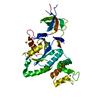+ Open data
Open data
- Basic information
Basic information
| Entry | Database: PDB / ID: 2ykr | ||||||
|---|---|---|---|---|---|---|---|
| Title | 30S ribosomal subunit with RsgA bound in the presence of GMPPNP | ||||||
 Components Components |
| ||||||
 Keywords Keywords | RIBOSOME/HYDROLASE / RIBOSOME-HYDROLASE COMPLEX / RIBOSOME BIOGENESIS / YJEQ / CIRCULARLY PERMUTATED GTPASE | ||||||
| Function / homology |  Function and homology information Function and homology informationguanosine tetraphosphate binding / ornithine decarboxylase inhibitor activity / transcription antitermination factor activity, RNA binding / misfolded RNA binding / Group I intron splicing / RNA folding / Hydrolases; Acting on acid anhydrides; In phosphorus-containing anhydrides / four-way junction DNA binding / negative regulation of translational initiation / regulation of mRNA stability ...guanosine tetraphosphate binding / ornithine decarboxylase inhibitor activity / transcription antitermination factor activity, RNA binding / misfolded RNA binding / Group I intron splicing / RNA folding / Hydrolases; Acting on acid anhydrides; In phosphorus-containing anhydrides / four-way junction DNA binding / negative regulation of translational initiation / regulation of mRNA stability / mRNA regulatory element binding translation repressor activity / positive regulation of RNA splicing / regulation of DNA-templated transcription elongation / transcription elongation factor complex / transcription antitermination / DNA endonuclease activity / DNA-templated transcription termination / maintenance of translational fidelity / mRNA 5'-UTR binding / GDP binding / regulation of translation / ribosome biogenesis / ribosomal small subunit biogenesis / ribosomal small subunit assembly / small ribosomal subunit / small ribosomal subunit rRNA binding / cytosolic small ribosomal subunit / cytoplasmic translation / tRNA binding / negative regulation of translation / rRNA binding / structural constituent of ribosome / ribosome / translation / ribonucleoprotein complex / response to antibiotic / mRNA binding / GTPase activity / GTP binding / RNA binding / zinc ion binding / metal ion binding / membrane / cytosol / cytoplasm Similarity search - Function | ||||||
| Biological species |  | ||||||
| Method | ELECTRON MICROSCOPY / single particle reconstruction / cryo EM / Resolution: 9.8 Å | ||||||
 Authors Authors | Guo, Q. / Yuan, Y. / Xu, Y. / Feng, B. / Liu, L. / Chen, K. / Lei, J. / Gao, N. | ||||||
 Citation Citation |  Journal: Proc Natl Acad Sci U S A / Year: 2011 Journal: Proc Natl Acad Sci U S A / Year: 2011Title: Structural basis for the function of a small GTPase RsgA on the 30S ribosomal subunit maturation revealed by cryoelectron microscopy. Authors: Qiang Guo / Yi Yuan / Yanji Xu / Boya Feng / Liang Liu / Kai Chen / Ming Sun / Zhixiu Yang / Jianlin Lei / Ning Gao /  Abstract: The bacterial RsgA, a circularly permutated GTPase, whose GTPase activity is dependent on the 30S ribosomal subunit, is a late-stage ribosome biogenesis factor involved in the 30S subunit maturation. ...The bacterial RsgA, a circularly permutated GTPase, whose GTPase activity is dependent on the 30S ribosomal subunit, is a late-stage ribosome biogenesis factor involved in the 30S subunit maturation. The role of RsgA is to release another 30S biogenesis factor, RbfA, from the mature 30S subunit in a GTP-dependent manner. Using cryoelectron microscopy, we have determined the structure of the 30S subunit bound with RsgA in the presence of GMPPNP at subnanometer resolution. In the structure, RsgA binds to the central part of the 30S subunit, close to the decoding center, in a position that is incompatible with multiple biogenesis factors, all three translation initiation factors, as well as A-, P-site tRNAs and the 50S subunit. Further structural analysis not only provides a structural model for the RsgA-dependent release of RbfA from the nascent 30S subunit, but also indicates RsgA's role in the ribosomal protein assembly, to promote some tertiary binding protein incorporation. Moreover, together with available biochemical and genetic data, our results suggest that RsgA might be a general checkpoint protein in the late stage of the 30S subunit biogenesis, whose function is not only to release biogenesis factors (e.g., RbfA) from the nascent 30S subunit, but also to block the association of initiation factors to the premature 30S subunit. | ||||||
| History |
|
- Structure visualization
Structure visualization
| Movie |
 Movie viewer Movie viewer |
|---|---|
| Structure viewer | Molecule:  Molmil Molmil Jmol/JSmol Jmol/JSmol |
- Downloads & links
Downloads & links
- Download
Download
| PDBx/mmCIF format |  2ykr.cif.gz 2ykr.cif.gz | 1.4 MB | Display |  PDBx/mmCIF format PDBx/mmCIF format |
|---|---|---|---|---|
| PDB format |  pdb2ykr.ent.gz pdb2ykr.ent.gz | 893.4 KB | Display |  PDB format PDB format |
| PDBx/mmJSON format |  2ykr.json.gz 2ykr.json.gz | Tree view |  PDBx/mmJSON format PDBx/mmJSON format | |
| Others |  Other downloads Other downloads |
-Validation report
| Summary document |  2ykr_validation.pdf.gz 2ykr_validation.pdf.gz | 1 MB | Display |  wwPDB validaton report wwPDB validaton report |
|---|---|---|---|---|
| Full document |  2ykr_full_validation.pdf.gz 2ykr_full_validation.pdf.gz | 3.7 MB | Display | |
| Data in XML |  2ykr_validation.xml.gz 2ykr_validation.xml.gz | 432 KB | Display | |
| Data in CIF |  2ykr_validation.cif.gz 2ykr_validation.cif.gz | 586.8 KB | Display | |
| Arichive directory |  https://data.pdbj.org/pub/pdb/validation_reports/yk/2ykr https://data.pdbj.org/pub/pdb/validation_reports/yk/2ykr ftp://data.pdbj.org/pub/pdb/validation_reports/yk/2ykr ftp://data.pdbj.org/pub/pdb/validation_reports/yk/2ykr | HTTPS FTP |
-Related structure data
| Related structure data |  1884MC M: map data used to model this data C: citing same article ( |
|---|---|
| Similar structure data |
- Links
Links
- Assembly
Assembly
| Deposited unit | 
|
|---|---|
| 1 |
|
- Components
Components
-30S RIBOSOMAL PROTEIN ... , 20 types, 20 molecules BCDEFGHIJKLMNOPQRSTU
| #2: Protein | Mass: 24253.943 Da / Num. of mol.: 1 / Fragment: RESIDUES 9-226 / Source method: isolated from a natural source / Source: (natural)  |
|---|---|
| #3: Protein | Mass: 23078.785 Da / Num. of mol.: 1 / Fragment: RESIDUES 2-207 / Source method: isolated from a natural source / Source: (natural)  |
| #4: Protein | Mass: 23383.002 Da / Num. of mol.: 1 / Fragment: RESIDUES 2-206 / Source method: isolated from a natural source / Source: (natural)  |
| #5: Protein | Mass: 15804.282 Da / Num. of mol.: 1 / Fragment: RESIDUES 10-159 / Source method: isolated from a natural source / Source: (natural)  |
| #6: Protein | Mass: 11669.371 Da / Num. of mol.: 1 / Fragment: RESIDUES 1-100 / Source method: isolated from a natural source / Source: (natural)  |
| #7: Protein | Mass: 16861.523 Da / Num. of mol.: 1 / Fragment: RESIDUES 2-152 / Source method: isolated from a natural source / Source: (natural)  |
| #8: Protein | Mass: 14015.361 Da / Num. of mol.: 1 / Fragment: RESIDUES 2-130 / Source method: isolated from a natural source / Source: (natural)  |
| #9: Protein | Mass: 14554.882 Da / Num. of mol.: 1 / Fragment: RESIDUES 4-130 / Source method: isolated from a natural source / Source: (natural)  |
| #10: Protein | Mass: 11196.988 Da / Num. of mol.: 1 / Fragment: RESIDUES 5-102 / Source method: isolated from a natural source / Source: (natural)  |
| #11: Protein | Mass: 12487.200 Da / Num. of mol.: 1 / Fragment: RESIDUES 13-129 / Source method: isolated from a natural source / Source: (natural)  |
| #12: Protein | Mass: 13636.961 Da / Num. of mol.: 1 / Fragment: RESIDUES 2-124 / Source method: isolated from a natural source / Source: (natural)  |
| #13: Protein | Mass: 12625.753 Da / Num. of mol.: 1 / Fragment: RESIDUES 2-115 / Source method: isolated from a natural source / Source: (natural)  |
| #14: Protein | Mass: 11475.364 Da / Num. of mol.: 1 / Fragment: RESIDUES 2-101 / Source method: isolated from a natural source / Source: (natural)  |
| #15: Protein | Mass: 10159.621 Da / Num. of mol.: 1 / Fragment: RESIDUES 2-89 / Source method: isolated from a natural source / Source: (natural)  |
| #16: Protein | Mass: 9207.572 Da / Num. of mol.: 1 / Source method: isolated from a natural source / Source: (natural)  |
| #17: Protein | Mass: 9263.946 Da / Num. of mol.: 1 / Fragment: RESIDUES 4-83 / Source method: isolated from a natural source / Source: (natural)  |
| #18: Protein | Mass: 6466.477 Da / Num. of mol.: 1 / Fragment: RESIDUES 20-74 / Source method: isolated from a natural source / Source: (natural)  |
| #19: Protein | Mass: 9057.626 Da / Num. of mol.: 1 / Fragment: RESIDUES 3-81 / Source method: isolated from a natural source / Source: (natural)  |
| #20: Protein | Mass: 9506.190 Da / Num. of mol.: 1 / Fragment: RESIDUES 3-87 / Source method: isolated from a natural source / Source: (natural)  |
| #21: Protein | Mass: 6067.081 Da / Num. of mol.: 1 / Fragment: RESIDUES 4-54 / Source method: isolated from a natural source / Source: (natural)  |
-RNA chain / Protein , 2 types, 2 molecules AW
| #1: RNA chain | Mass: 496892.375 Da / Num. of mol.: 1 / Source method: isolated from a natural source / Source: (natural)  |
|---|---|
| #22: Protein | Mass: 39233.246 Da / Num. of mol.: 1 Source method: isolated from a genetically manipulated source Source: (gene. exp.)   References: UniProt: E3PE32, UniProt: P39286*PLUS, Hydrolases; Acting on acid anhydrides; In phosphorus-containing anhydrides |
-Experimental details
-Experiment
| Experiment | Method: ELECTRON MICROSCOPY |
|---|---|
| EM experiment | Aggregation state: PARTICLE / 3D reconstruction method: single particle reconstruction |
- Sample preparation
Sample preparation
| Component | Name: 30S RIBOSOMAL SUBUNIT WITH RSGA BOUND IN THE PRESENCE OF GMPPNP Type: RIBOSOME |
|---|---|
| Buffer solution | pH: 7.6 |
| Specimen | Embedding applied: NO / Shadowing applied: NO / Staining applied: NO / Vitrification applied: YES |
| Specimen support | Details: OTHER |
| Vitrification | Instrument: FEI VITROBOT MARK I / Cryogen name: ETHANE |
- Electron microscopy imaging
Electron microscopy imaging
| Experimental equipment |  Model: Titan Krios / Image courtesy: FEI Company |
|---|---|
| Microscopy | Model: FEI TITAN KRIOS |
| Electron gun | Electron source:  FIELD EMISSION GUN / Accelerating voltage: 300 kV / Illumination mode: FLOOD BEAM FIELD EMISSION GUN / Accelerating voltage: 300 kV / Illumination mode: FLOOD BEAM |
| Electron lens | Mode: BRIGHT FIELD / Nominal magnification: 59000 X / Nominal defocus max: 3850 nm / Nominal defocus min: 2000 nm / Cs: 2.7 mm |
| Image recording | Electron dose: 20 e/Å2 / Film or detector model: FEI EAGLE (4k x 4k) |
| Radiation wavelength | Relative weight: 1 |
- Processing
Processing
| EM software | Name: SPIDER / Category: 3D reconstruction | |||||||||||||||||||||
|---|---|---|---|---|---|---|---|---|---|---|---|---|---|---|---|---|---|---|---|---|---|---|
| CTF correction | Details: MAPS FROM EACH DEFOCUS GROUP | |||||||||||||||||||||
| Symmetry | Point symmetry: C1 (asymmetric) | |||||||||||||||||||||
| 3D reconstruction | Method: REFERENCE BASED / Resolution: 9.8 Å / Num. of particles: 77483 / Nominal pixel size: 2.9 Å / Actual pixel size: 2.9 Å Details: SUBMISSION BASED ON EXPERIMENTAL DATA FROM EMDB EMD -1884. (DEPOSITION ID: 7882). Symmetry type: POINT | |||||||||||||||||||||
| Atomic model building | Protocol: FLEXIBLE FIT / Space: REAL / Target criteria: Cross-correlation coefficient / Details: METHOD--MDFF REFINEMENT PROTOCOL--X-RAY | |||||||||||||||||||||
| Atomic model building |
| |||||||||||||||||||||
| Refinement | Highest resolution: 9.8 Å | |||||||||||||||||||||
| Refinement step | Cycle: LAST / Highest resolution: 9.8 Å
|
 Movie
Movie Controller
Controller








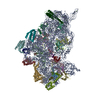
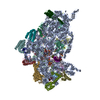

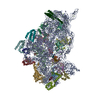
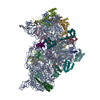
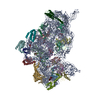
 PDBj
PDBj






























